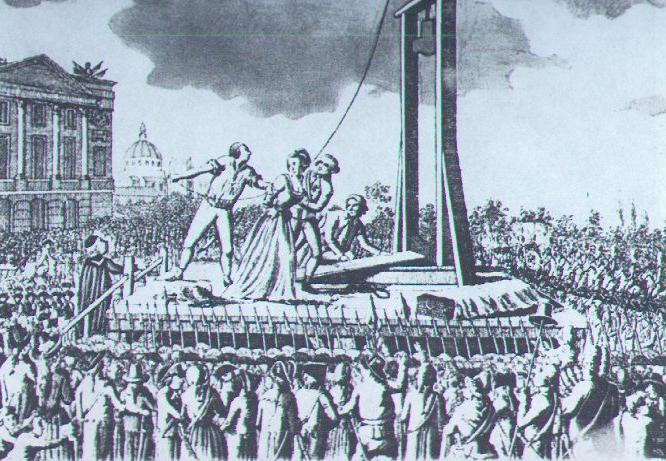
If the excesses of the French Revolution generated fear and horror among the establishment in Scotland, the ideas behind the revolution gave hope to many of the ordinary people that something similar might happen in Scotland. The government of Britain actually did have reason to fear that revolutionary ideas would spread from France. In January, 1798, the government uncovered plans for a general uprising in Scotland and the establishment of a Scottish Republic.
Nine prominent Scotsmen, including progressive members of the London parliament and several Scottish peers, were named as members of the 'Provisional Government of the Scottish Republic'. The president of this government was a young Scottish lawyer named Thomas Muir. Muir had already been sentenced to fourteen years transportation to the penal colony at Botany Bay but had made a daring escape in an American warship and made his way to France where he had been honoured as the first non Frenchman to be made a citizen of the republic.
The Scottish republican movement had started its life in the aftermath of the American War of Independence and the French Revolution. A movement called The Friends of the People had been formed to sever the Union of 1707 and establish an independent Scottish republic. Thomas Muir had been a prominent leader of this movement and during trips to Belfast he had been made an honorary member of the United Irishmen. He even opened links with Brittany, where he was in touch with the famous Marquis La Fayette who had fought in the American War of Independence along with hundreds of Bretons. It was from Brittany that the French Revolution had actually been given its kick-start.
Many leaders of the Friends of the People were arrested and tried for crimes from high treason to sedition. Robert Watt and David Downie had been arrested with incriminating plans for an uprising in which Edinburgh Castle was to be seized. Robert Watt became the first Scottish republican to suffer the death sentence. After being hanged, his head was cut off and thrown to the people.
With most of the leadership of the Friends of the People arrested, a new totally secret revolutionary organisation had to be creaated. It was called the United Scotsmen, taking its name from the Irish model. By the Spring of 1797, the United Scotsmen were active, based on local cells of not more than sixteen people sending a delegate to committees at parochial, then county and then national levels. The National Convention met every seven weeks in different locations, usually within the vicinity of Glasgow, Stirling or Edinburgh.
In 1797 affairs came to a head in Scotland mainly due to the Militia Act in which the government had passed a law conscripting able bodied Scots males, between nineteen and twenty-three years old, for military service. Riots were breaking out in Kirkintilloch, Freuchie, Strathaven, Galston, Dalry and throughout Aberdeen. The Government responded by sending in troops. People were being killed and wounded.
In January, 1797, the French had mistakenly sent troops to England. The plan was to land two armies, one at Bristol and one at Hull, appealing to English republicans to join them. The armies were commanded by American and Irish officers. By mistake the troops heading for Bristol landed at Fishguard. It was a silly mistake. The situation in England was different than in Ireland and Scotland and the English with republican sympathies were English first and republican afterwards. The French had also tried to land in Bantry Bay in December, 1796, and this caused General Lake to start disarming the United Irishmen in Ulster.
Whether there was a disagreement among the National Executive as to the time to strike is not clear. But, it appears, Angus Cameron of Perth decided to act on his own and issued a call to the United Scotsmen to rise in Perth. Reports indicate that 16,000 men answered Cameron's call. They included a cavalry regiment.
The United Scotsmen had initial success. They captured Castle Menzies and forced Sir John Menzies to declare against the Militia Act. They marched on Blair Castle where the Duke of Atholl was forced to surrender. Then a detachment went to Taymouth Castle, near Kenmore, residence of the Earls of Breadalbane. This was also a military headquarters and the United Scotsmen were able to seize its armoury.
Thousands of English troops poured into the country. These line regiments were used because the commander in Scotland was afraid of sending Scottish troops against their fellow countrymen. Faced with superior forces, Cameron proved a good commander. His army simply melted back into the population. He and Menzies were never caught and eventually settled in America.
On July 17, 1797, an Act of parliament declared the United Scotsmen illegal and any member liable to an immediate seven years transportation. In November, 1797, trials for sedition started and George Mealmaker, a Dundee weaver, was sentenced to fourteen years, while other members received various terms of transportation and imprisonment. Over the next four years, many Scotsmen were to be tried for treason and sedition as members of the United Scotsmen.
Sources
Revolution in Scotland: http://1798.blogeasy.com/site.about.run